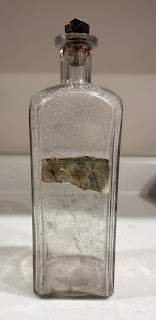Mariettan Ross Thomas showed me an old apothecary bottle and said, "See what you can find out about it." The quart-size glass bottle has a cork and a label: "Wm H. Styer, Prescription Druggist, 240 Front Street, Marietta, Ohio." The label included space for the name of doctor and prescription number.
Collecting old bottles is popular. There is a Federation of Historical Bottle Collectors, one of many organizations of collectors. Just so you know, their national convention this year is in Reno NV.
This bottle has a story to tell. I found another W. H. Styer bottle for sale (shown below) at worthpoint.com. It is smaller but with a beautiful inscription and monogram. I was impressed that a small-town local business would have such distinctive glassware.
William H. Styer was a druggist, entrepreneur, and business leader. An excerpt from the 1900 Century Review of Marietta, Ohio: "Styer commenced laboratory work in 1865, clerked in a drug store for several years and in 1881 opened a store at his present quarters 240 Front St…Mr. Styer started a branch store at 124 Putnam st. in 1888, which he still controls. He carries a large line of drugs, medicines, paints and sundries, in fact the full line kept by druggists generally excepting wallpaper. He is a vice president of The Dime Saving Society and Stevens Organ and Piano Company."
W. H. Styer Drugstore at 240 Front St. CA 1900 copied from Century Review Marietta, Ohio
Drugstores were a mainstay of retail business and healthcare from the late 1800s to today. A 1903 directory listed ten drugstores: Curtis & Hutchman, A. J. Richard, W. H. Styer, H. N. Curtis, Beagle & Lytle, Union Drug Co., Chas. R. Buchanan, Will Richardson and J. L. Mason.
Drugstores filled prescriptions and sold over-the-counter supplements, remedies, and cure-alls for every possible ailment. Some medicines were legitimate; many were not. There was no Food and Drug Administration to monitor contents and no Federal Trade Commission to prevent outlandish claims.
You could buy many other convenience store-type items, even home improvement goods like paint and wallpaper. Starting in the early 1900s many drug stores added soda fountain counters which dispensed flavored carbonated drinks and milkshakes. No mention of that for Styer, though he opened a "branch" store on Putnam Street which may have had one.
Ads for drugstores, often a dozen or more in a single edition, were common in newspaper editions. Some examples from late 1800s and early 1900s in the Marietta Register newspaper:
- Beagle and Lyle's Drug Store sold Halstead's Pepsin-Fruit syrup for babies to "regulate their bowels."
- Dr. Bull's cough syrup would cure pleurisy and pneumonia.
- Celery King was advertised for constipation and much more.
- Multiple drug stores advertised a sale for dozens of remedies: "The Greatest Patent Medicine Sale in the History of Man."
- W.H. Styer’s Putnam Street Drugstore sold "Styer's Sarsaparila...a blood purifier."
- J. W. Dysle & Co druggists sold Chamberlain's Cough Remedy and....wallpaper, "the prettiest papers ever brought to the city."
- Sexine Pills would make you "Strong Again!, New life, strength, and vigor."
- Curtis and Hutchman in Marietta sold Dr. Mott's Nerverine Pills which offered to restore "failing or lost manhood,” and
- Dr. Peals Pennyroyal Pills would provide "relief for ladies," presumably from menstrual cramps.
History can be endlessly fascinating. Every single artifact – such as an antique bottle, person, and building has a story to tell.



No comments:
Post a Comment